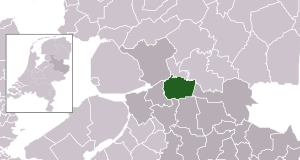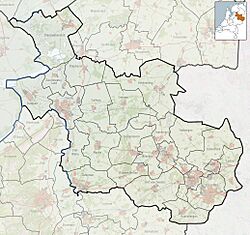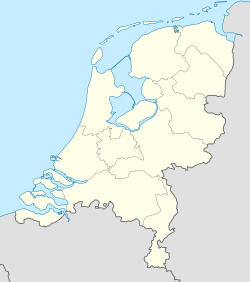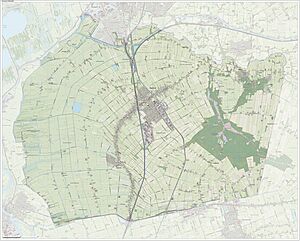Staphorst facts for kids
Quick facts for kids
Staphorst
|
|||
|---|---|---|---|

Staphorst city hall
|
|||
|
|||

Location in Overijssel
|
|||
| Country | Netherlands | ||
| Province | Overijssel | ||
| Government | |||
| • Body | Municipal council | ||
| Area | |||
| • Total | 135.69 km2 (52.39 sq mi) | ||
| • Land | 134.22 km2 (51.82 sq mi) | ||
| • Water | 1.47 km2 (0.57 sq mi) | ||
| Elevation | 1 m (3 ft) | ||
| Population
(May 2014)
|
|||
| • Total | 16,396 | ||
| • Density | 122/km2 (320/sq mi) | ||
| Demonym(s) | Staphorstenaar, Staphorster | ||
| Time zone | UTC+1 (CET) | ||
| • Summer (DST) | UTC+2 (CEST) | ||
| Postcode |
7715, 7950–7955
|
||
| Area code | 0522 | ||
Staphorst is a town and a municipality located in the eastern part of the Netherlands. It is known for its unique history and traditions.
Contents
History of Staphorst
How Staphorst Villages Began
The villages of Staphorst and Rouveen started in the 13th century. Monks began to clear and use the wet, swampy lands. They turned these areas into farmland.
Long Villages and Farm Life
All the farms were built along a long road through the swampy area. This created a very long row of farms. The village of Staphorst-Rouveen became about 11 kilometers (7 miles) long. This type of long village is called lintbebouwing in Dutch, which means "ribbon urbanization." You can see similar villages in other parts of the Netherlands.
Staphorst's Unique Borders
In 1811, the French emperor Napoleon made a special rule. He combined four smaller areas into one larger municipality. This new area included Rouveen, Staphorst, and IJhorst. Since 1818, it has been known as Staphorst. Its borders have stayed almost the same since then, which is quite unusual for Dutch municipalities.
Farm Land Division
A special tradition in Staphorst was how land was divided. After a farmer passed away, his land was often split among his sons. If a son did not inherit the main farmhouse, he would build his own house behind his father's. This led to many pieces of farmland being very long but narrow. For example, some plots might be 1500 meters long but only 40 meters wide.
Traditional Farmhouses
The farms in Staphorst are built in a traditional style called Low Saxon. They often have green doors and window shutters. Most of the farms you see today were built between 1850 and 1910.
Community Life
Staphorst is known for its strong community and traditions. Many people in the village follow strict religious customs. It has one of the highest rates of church attendance in the Netherlands.
Health and Community Choices
In 1971, Staphorst was in the news because of a polio outbreak. Some people in the area choose not to get vaccinated for religious reasons. Because of this, the WHO (World Health Organization) considers Staphorst and similar areas in the Netherlands as places where certain diseases could spread more easily.
Birth Rates
Staphorst has a high birth rate compared to other places in Europe. In 2003, its birth rate was one of the highest in the Netherlands. This means many babies are born there each year.
Villages and Towns in Staphorst
The municipality of Staphorst includes several smaller villages and towns. These are:
- Halfweg
- Hamingen
- IJhorst
- Lankhorst
- De Leijen
- Punthorst
- Rouveen
- Slingenberg
- Staphorst
Notable People from Staphorst
Staphorst has been home to several interesting people, including artists and athletes.
Art and History
- Lambertus Johannes Hansen (1803–1859): A Dutch painter.
- Tjerk Vermaning (1929–1986): A Dutch amateur archaeologist.
- Roelof Bisschop (born 1956): A Dutch historian and politician.
Sports Stars
- Marc Houtzager (born 1971): A Dutch show jumping rider who won a silver medal at the 2012 Summer Olympics.
- Bert Konterman (born 1971): A former professional footballer who played many games for clubs in the Netherlands and Scotland.
- Gretha Smit (born 1976): A Dutch former speed skater who won a silver medal at the 2002 Winter Olympics.
Images for kids
See also
 In Spanish: Staphorst para niños
In Spanish: Staphorst para niños












